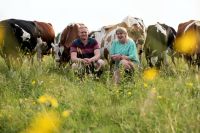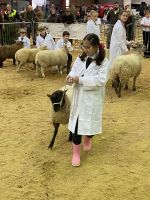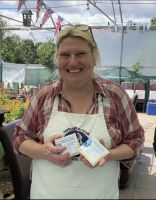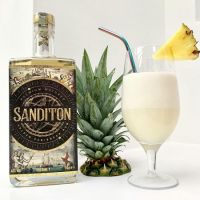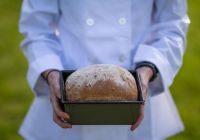
“While Dad worked at the docks in London, mum would take us kids up to Kent over the summer. We’d be up at 7am, and mum would make us sandwiches for the three-mile walk to the hop fields. I was only a babe in arms but as soon as I could walk properly, I would scrape hops off the floor and collect them in an umbrella. We all had to pick, it didn’t matter about our age.”
Sixty-seven year old Colin Felton’s memories of journeying from the East End for his hop picking “holiday” in the Kent countryside are not unique. Until the 1960s, some 10,000 people – often, whole streets of families – would leave the stench of the city for the sweet aroma of Kent’s ‘hop gardens’ each September.
Sixty-five years later, Colin is still working at the Beltring farm (once owned by Whitbread’s) that he came to as a youth, but today he’s the on-site historian showing tourists around what has become a relic of a bygone era.
Where once there were 46,000 acres of hops – providing the bitter tang to British beers – only 1,000 now survive. Fruit gradually replaced hops and machines replaced the pickers.
“In 1982 I moved to Kent permanently because I had such very happy childhood memories here,” says Colin. “I miss those days terribly.”
While Colin, and the thousands like him, may never see a return to the hop picking days of old, over the last decade the industry itself has enjoyed something of a renaissance. Under threat from foreign producers, it has moved away from its traditional roots and begun innovating; with dwarf hop varieties that make harvesting easier and the introduction of new, flavoursome varieties. Coupled with greater demand for ‘hoppy’ ales and a growth in microbreweries, the British hop industry is finding a new and emerging market for this ancient crop.
A hop from London
Kent became the focus of the hop industry thanks to protestant refugees from Flanders who came to the area and began growing hops. “Having the right field structure – rich soils and a microclimate with cold winds from the North Sea – it was perfect for hops, so they stayed,” says hop breeder and researcher Dr Peter Darby.
By the 1800s, hops were making their mark on the social history of the country too. “When beer became an essential commodity of the Empire, a big labour force was needed to pick hops,” says Peter. “Trainloads came on ‘Hopper Specials’ from the East End, and it’s said that some of the growers even walked (some 60 miles from London to Canterbury) to get to the fields. They brought all their household goods with them – even the kitchen sink!”
When these migratory families reached the hop farms, conditions were far from what you’d expect from a “holiday”.
“The huts were 9ft square, and we had two beds, one for the three girls and mum and then one for me and my three brothers,” says Colin, whose family would pick for up to five weeks at a stretch. “At 5pm we’d come back from the fields and have a cold wash. It was harder to get warm water because you’d have to light a fire.”
With upwards of 80,000 people needed to pick the harvest, “home pickers” were also employed. Local girl Jean Brown, who lived at Nash Cottage in Marden, recalls her mum making all their clothes.
“Mum used to make a lot in her spare time and did all the washing by hand. With six children, she needed to be a strong woman, but in 1946 with the war over, they had everything to live for,” she says.
Indeed, despite the stories of primitive conditions, and the hard work involved, many pickers look back on this time with fondness.
“Dad would come up at weekends and mum and him would go to the pub, while us kids would go fishing, scrumping or walking,” says Colin. “We didn’t get up to mischief because we didn’t want the farmer to ban us from coming again – it was our holiday after all. Sometimes we’d miss school, but no one said much about it because we were earning money and people understood.”
Jean is similarly nostalgic. “I remember being shown hairy hopdogs (caterpillars about 5cms long) crawling on the hop leaves,” she says. “And my afternoon nap was encouraged by my mum throwing her coat over a pile of hop bines to make a nest. I’d go to sleep by watching the clouds go by. Hop picking wasn't such a hardship, they were happy times.”
End of an era
But the holidays – and the work – soon came to an end. “In 1968, the Whitbread farm was flooded by the River Medway and the new owners said they wouldn’t rebuild the old huts; they got a machine in to pick instead,” recalls Colin. “Mum still came down for the first few years and worked on the picking machines – but she couldn’t stand it. It wasn’t the same as being out in the fresh air.”
The farm owner’s reluctance to invest in the huts marked a wider shift – and decline – in hop growing in the area.
“A series of things came together to cause the decline,” says Peter Darby. “But the main thing was a change in people’s tastes, from hoppy beers to lager, and the deregulation of the English hop industry, which opened the domestic industry to fierce international competition.”
Faced with such competition from American, New Zealand, German and Japanese hop growers, many UK farmers simply ripped up their hop poles in favour of cheaper, easier cash crops. Along with the hops, the beautiful Victorian oast houses, purposely designed for the hop drying process – working like giant tumble dryers – were instead converted into desirable residences.
To compound this, the hops, the tallest and the most unusual temperate crop in the UK, also became the victim of devastating diseases. All of which spelled the death knell for the industry.
Hop heritage
But thanks to people like Peter Darby, research Director at Wye Hops Ltd (once part of Wye College) – who was tasked with breeding new strains and hop varieties that would be more productive and more disease resistant – and brewers like Faversham-based Shepherd Neame, the threat to the hop industry was averted.
“Although a collection of hop varieties was started 100 years ago at Wye College as a resource for students, when the college closed in 1981 it was considered a high priority that it was maintained,” says Peter. “And I was asked to safeguard it.”
But far from being rows of dusty seeds in envelopes, as one might imagine, the hop collection consisted of hundreds of living plants.
“Shepherd Neame kindly donated the land at Queen Court Farm, near Faversham, and I was tasked with making sure they were in the ground and growing,” says Peter. “After all, the heritage of the hop industry in England was at stake.”
Today, all bar 20 of the 1,000 hop plants are extremely rare and unique, ranging from early varieties such as 1738 ‘Mathon’ and the 1875 ‘Fuggle’, to the more recent ‘Sovereign’ and ‘Pilgrim’.
A great deal of Peter’s work is focused on developing new strains – “there is a pedigree for flavour rather like race horses”, says Peter – and he’s proud to have developed the world’s first dwarf variety ‘First Gold’. Dubbed ‘hedgerow hops’ for their lower growth – 8-10ft as opposed to the conventional 15-16ft – these hedges of hops can be harvested in a row with a tractor, lowering the amount of labour needed by some 25 per cent.
“Britain is leading the way in this kind of hop innovation,” says Peter.
Beautiful beer
So what does the future now hold for the industry? While continuity of supply can be an issue here – hops take up to two years to produce hops from new rootstocks in Britain, unlike in hotter climates where they can produce in the first year – and the introduction of more productive varieties means acreage is unlikely to go back to what it once was, the future looks secure.
Shepherd Neame is one of the prominent UK brewers now experimenting with English hops – using Kentish ‘aroma hops’, such as ‘Goldings’, to give peppery, spicy characteristics to its beer – and making Kentish ale a distinct regional product akin to Parma Ham and Champagne.
“As Britain’s oldest brewery, we’ve been closely aligned with the local hop industry for centuries and it’s very important that our beers reflect that,” says head brewer Richard Frost. “The resurgence in popularity for cask ales is also helping to protect the industry; beer drinkers are now more discerning and want their beer to have different characters.”
In fact, such is the reputation of Kentish hops, that some 25 per cent get shipped to US brewers each year, where they’re used to enhance their craft brews.
“It’s rather like wine was in the 60s; the French knew about it but the average British consumer didn’t have much knowledge. Now people are beginning to be fascinated by the nuances different hops can bring to beer and even the bigger brewers are rethinking their use of hops,” says Peter.
For the 30,000 people that visit the Faversham Hop Festival on the first weekend in September each year – to bless the hop harvest, don a hop garland, drink real ales and attend guided hop walks and tours – hops clearly remain important.
“Hops still have a big relevance to the community here and hop history, and the part it played in this region, is something the community are keen to preserve,” says Shepherd Neame’s production and distribution director Tom Falcon.
Colin Felton is still preserving his own slice of hop heritage; looking after, and showing visitors around the four remaining oast houses at The Hop Farm, in Paddock Wood, Tonbridge – the largest collection of oast houses in one area in the world.
And, while the farm’s ‘Hop Story’ may be harder to hear these days over the backdrop of the farm’s amusements and family entertainments, for Colin it remains an enduring memory.
“Hop picking for me was about the family being all together for the summer; it was lovely, and we thoroughly enjoyed ourselves,” says Colin. “It was the greatest time of my life, and I’ll never forget it.”
Follow this link to search for local beers
Tags: hops
British beer



